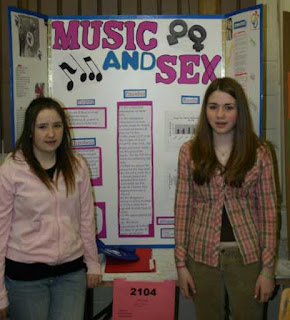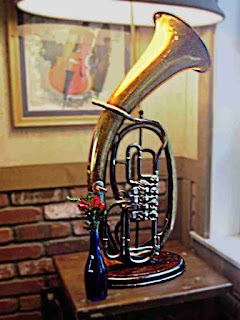(The embedded player doesn't work? Click here.)
Meanwhile, suppose you just wanted to simply hear my piece Wagner and Schubert Have Intercourse and not read all the upcoming palaver. Just scroll to the end of this post for the download link. It's easy. Or click HERE to skip down. Even easier. Yep.

Several years ago I had the idea to write a set of variations on not one but two musical themes. These would interact with each other according to their own musical nature and my own musical whimsey. In order to make the interweavings of such music easier to follow I decided to use familiar tunes not ones of my own creation.
The first two melodies I picked were White Christmas by Irving Berlin (Bing sings it on YouTube) and The Black Page by Frank Zappa (Mike plays it on YouTube). The combination of these two monochromatic titles suggested my title: Gray Area.
Once finished, I recognized two problems with Gray Area.
First, while I personally knew both melodies equally well, hardly anyone else did. Someone without that double familiarity would not be able to follow my arcane melodic combinatoriality.
Second, I would never have gotten copyright permissions especially considering the violence I did to those pieces. To my surprise I discovered more similarities between them than I ever would have expected. You'll have to re-discover those similarities on your own.

So I searched for two other melodies, equally familiar to any listener and both from the public domain. I wanted "iconic" tunes. This is a cultural quality, not a musical one. "Iconic" musical material holds some distinct pre-existing personal meaning to a listener. I presume such meaning exists even before anyone hears my piece.
As a rough analogy, imagine a painter creating an image of a rose. Presumably each person who sees it will associate the rose picture, to some degree, with their own personal experiences with roses. Maybe they were swept off their feet by a dozen of them. Or maybe they were physically scarred by falling into a thorny rose bush. Seeing the picture brings the memory back.
Such pre-existent meanings in music have been studiously wiped out by generations of modernist, serialist and minimalist abstractionists. These composers have still been able to create iconic references when they wanted them by setting lyrics - like, for instance, a poem about a rose.

Eventually I found two balanced themes which I feel hold this iconic stature. I chose Ave Maria by Franz Schubert (Bono and Pavarotti sing it on YouTube) and The Ride of the Valkyries from the opera Die Walkure by Richard Wagner (Levine leads Berlin Phil. on YouTube).
In contemporary culture, Ave Maria was sung prominently at memorials to 9/11 victims. Recently it was used as background to television commercials for the uber-violent movie Hitman. (Hear it in a theatrical trailer on YouTube)
The Ride of the Valkyries is used more often in our times. There's Elmer Fudd's hunting ditty in What's Opera, Doc? ("Kill the wabbit, Kill the wabbit!") (see it on YouTube while it lasts) and the here-comes-the-killer-helicopters music in Apocalypse Now (see it on YouTube). Recently it was used in this television advertisement for Red Bull.
Both melodies conjure imaginary women from revered mythologies. I want my use (and abuse) of these themes to push a few buttons. um, I mean, to refer to personal, pre-established meaning.

Having picked my starting material I did not pursue the project for quite a long time. But one day I thought up a title and I was suddenly ready to begin work. It was the perfect title to focus attention on the essential notion of combining two music themes into one piece. The title does this by associating the themes directly with their composers' persona.
I decided to call my piece Wagner And Schubert Have Sex.
I figured that alluding to the oft-discussed uncertain sexuality of these two famous composers might even attract some attention - or at least cause rolling of eyeballs. In our culture, sex sells.
I described my ideas to Leslie. She said "You should call it 'Wagner and Schubert Have Intercourse' instead. That way you can plausibly deny that you really mean actual SEX. The word 'intercourse' could refer to 'social intercourse'."
Good idea.
And so I hereby assert my right to plausibly deny that Wagner And Schubert Have Intercourse is actually about gay pedophilic sex between two immortals of western music, who, for all I know or care, never even met each other in person.

Remember, you're free to think anything you want about this music (or any other music). Listeners often think up all sorts of strange bizarre images that composers never intended. I expect any composer has the post-concert experience of listening to someone gush about their music-inspired visions of "purple teddy bears" or "inverted tropical islands" or "lightning powered racing cars".
If something in Wagner and Schubert Have Intercourse sparks your visual or dramatic imagination, that's perfectly fine. Run with it. But keep in mind that those images come from your head, not mine. All I've done is to write music using two famous familiar themes that you probably already know from past experience. And I also picked the title.
Should you think of a story to go along with my music - like a movie treatment - or maybe create artwork based on your reactions, please send it in. I'll post them. If you send anything x-rated please enclose it in a plain brown wrapper.

I expected that Wagner and Schubert Have Intercourse would last about eight or ten minutes max. It ended up being much longer and has five movements.
Movement three, which dwells on the accompaniment figures, was composed first. Next came movements two and four. The first and last movements started out as a long finale which I wanted to build to the climactic entry of the MYSTERY THEME. Only classical music nerds of the highest order are likely to recognize the MYSTERY THEME. This movement got out of hand and I split it in two. Placing the halves at beginning and end created a sort of a kind of a balance.
Also I realized that calling Wagner and Schubert Have Intercourse "variations" is misleading. There is no regular repeating harmonic structure, as in a classic theme and variations, to delineate one variation from the next. The themes are never manipulated by standard transformations like retrograde or inversion; they always appear going "forward". Sometimes the two themes are viciously simplified, emasculated even. At other times they are horribly distorted. They weave in and out of my own original material.

I realized it would be more helpful to compare this piece to Spy vs. Spy. In the well-known Mad Magazine cartoon feature there are two heroes (the Black Spy and the White Spy). I'm not saying that one of my themes is the "white" theme and the other "black". I am saying that the music might make more sense if you think of one of my themes as Franz and the other as Richard.
In the comic strip, the two spies battle it out in various scenarios. Sometimes one disappears for a long time only to reappear suddenly, strangely transformed or disguised. Sometimes one wins. Sometimes the other. And so it is with the Franz Theme and the Richard Theme in Wagner and Schubert Have Intercourse.

Last year, in the publicity surrounding the release of his book The Rest Is Noise, Alex Ross said:
A lot of 19th century music is about "the adventures of a theme." You recognize a theme, and then you start to hear its transformation; a second theme comes along, they start to interact, and you hear a story unfolding.By that description, my piece Wagner and Schubert Have Intercourse qualifies as 19th century. I think that's kind of cool but not terribly accurate. (This quote appeared in the Los Angeles Times, Sunday October 28, 2007 on page F12. Ross was interviewed by Scott Timberg. The article was entitled "The background notes from the 20th century" The whole article is available here, for a certain price, from the parsimonious L.A. Times)

Finally, a few words about methodology. Each movement of Wagner and Schubert Have Intercourse (indeed, all of my recent music available on Mixed Meters) is created in Sibelius music notation software on my laptop and recorded in real time. All sounds are from synthesizer or sampler software running simultaneously on the same computer. This all happens at my local Starbucks (so it can't be any good.)
During composition I never use real time input or manipulation. I do not use any musical keyboards or control devices. Every note, every rhythm, every dynamic change, every tempo change, every pitch bend, every mistuning and every mistake is entered and edited only via the QWERTY keyboard.
More importantly, these mp3 files are NOT Midi sketches or mockups anticipating performance by some mythical super-talented ensemble. Don't be confused by the use of easy-to-recognize, acoustic orchestral sounds. My pieces are really just electronic "tape" pieces, although these days "real" electronic tape pieces are mostly about lush sounds which mine are not.
I consider the music I present on Mixed Meters as completed. Having gotten this far all I want to do now is write other pieces and I want to keep enjoying the doing of it. Any further work on this piece would be a waste of my time and any potential performance would be no fun at all for me.

There are five movements to Wagner and Schubert Have Intercourse
- Endless Symphony (6'34")
- Aryan Artist's Aria (3'02")
- Endless Confession (5'13")
- Idle Idol's Idyll (4'17")
- Endless Opera (7'01")
DOWNLOAD HERE
Click here to download a zip file with all five movements of Wagner and Schubert Have Intercourse by David Ocker
Not sure you want to download the file? Here's the fourth movement, Idle Idol's Idyll, by itself - just one click away:
(The embedded player doesn't work? Click here.)
MORE LINKS
Here's something Wagner and Schubert had in common.
See the Richard Wagner Action Figure here. (found via)
Here's an article about one of Richard Wagner's possible fetishes.
Here's an article about Franz Schubert's possible sexuality.
The "Music and Sex Science Fair Project" picture came from here.
Other Westminster Gold album cover art (like the Die Walkure Volkswagen hubcaps) can be found here. (found via)
The roses are a variety named Excellenz von Schubert, probably not named after Franz. The rose picture came from here. There is another flower called a Franz Schubert Phlox. (No snickering, please.)
The 'Little Thinkers' Richard Wagner wind-up doll was on sale at the L.A. Philharmonic Store. (The tag identifies him as a member of The Unemployed Philosophers Guild.)
The picture of the Wagner Tuba lovingly made into a lamp was taken at Mimi's Cafe #68 in the Los Feliz district of Los Angeles.
Strictly German is an auto repair place in Pasadena which I've never used.
Alex Ross writes a blog called The Rest Is Noise. And here's my review of his book "The Rest Is Noise"
I'd like to thank my Beta-Listeners: Art, Ben, Bill, Eric, Israel, John and Scott. Their reactions didn't cause me to change the music at all, but they certainly had a big effect on my description of it.
WASHI Tags: Richard Wagner. . . Franz Schubert. . . David Ocker. . . composers. . . White Christmas. . . The Black Page. . . Gray Area. . . musical icons. . . Ave Maria. . . Ride of the Valkyries. . . Die Walkure. . . sex. . . intercourse. . . Wagner and Schubert Have Intercourse. . . mystery theme. . . Spy vs Spy. . . Alex Ross. . . Wagner Tuba. . . musical variations
2 comments :
Oh my gawd, those kids playing the Black Page with Mike Keneally. I'm about ready to hit myself in the head with my own guitar. KABONG!
The other day I saw a 2 (two) year old standing in front of a drum kit playing Earth Wind and Fire on a YouTube video. I'm not even sure I could count to four at 2 let alone bang it out rhythmically.
How about connecting Chopin to Beethoven then put them on a boat on the Los Angeles River?
I love the "axis" of cross streets.
Post a Comment